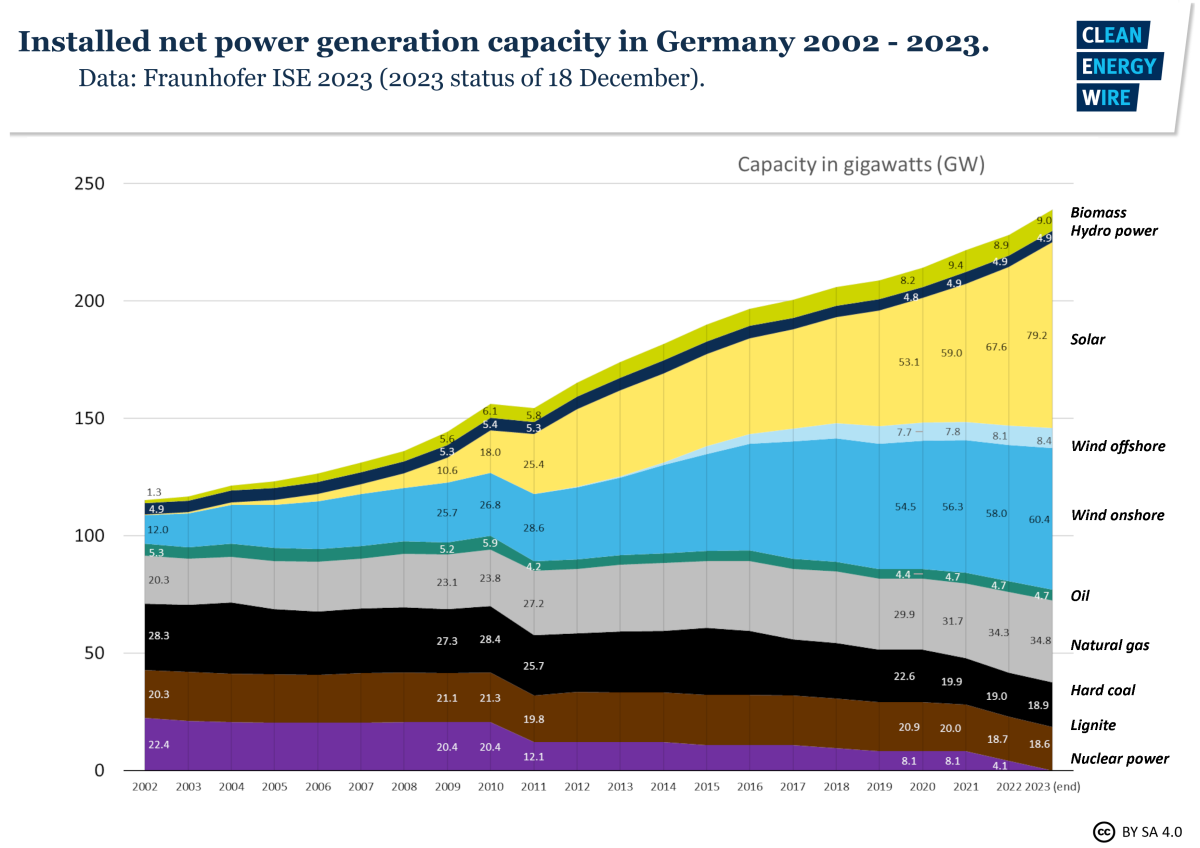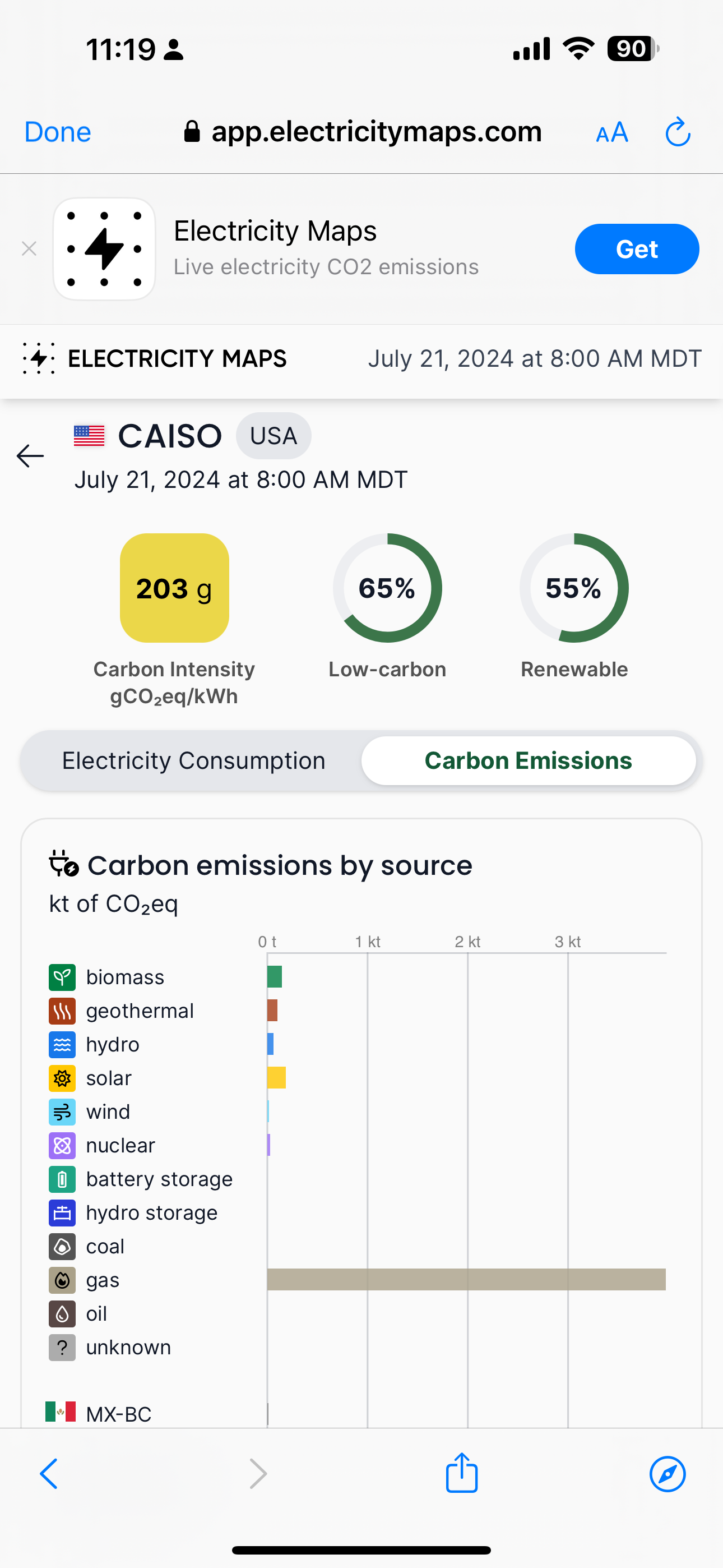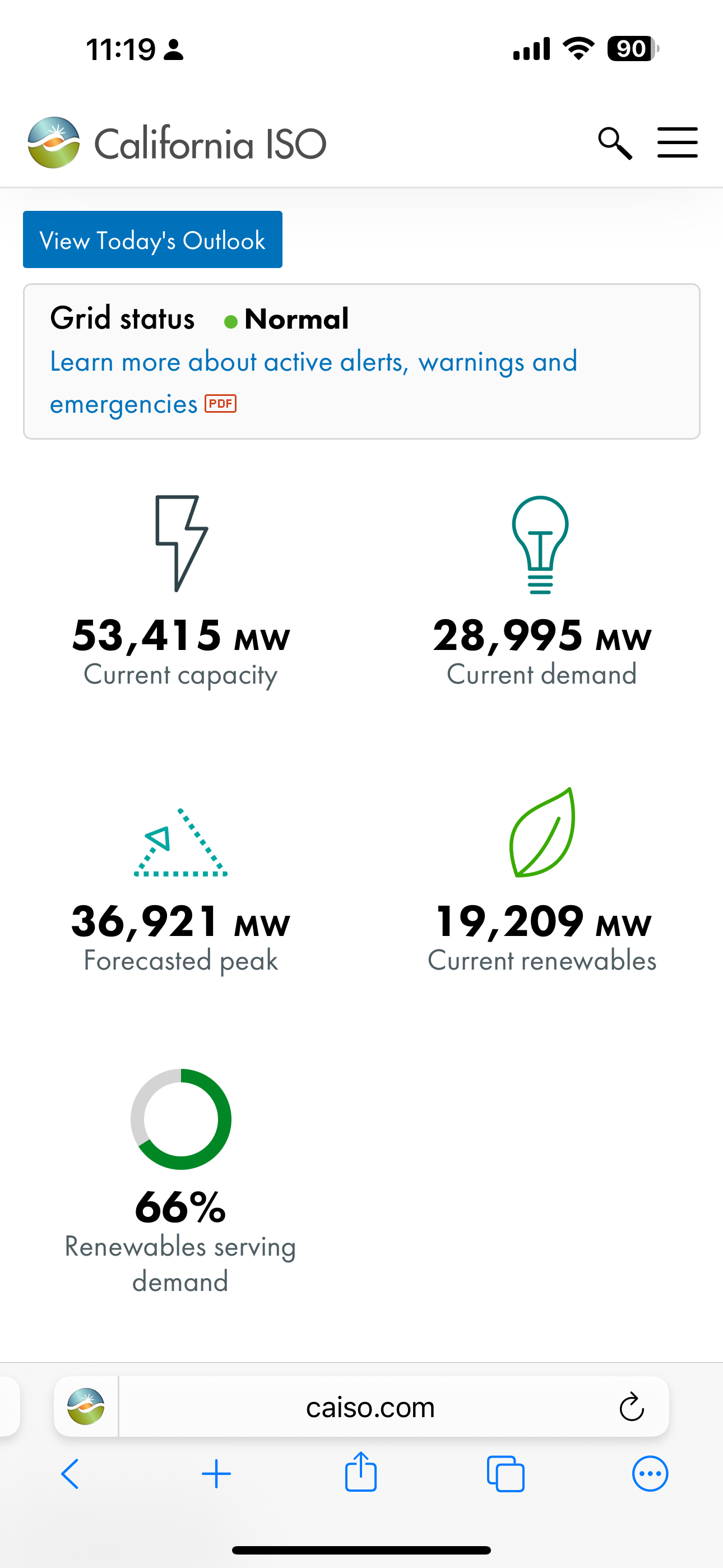- cross-posted to:
- memes@lemmy.ml
- cross-posted to:
- memes@lemmy.ml
Source - The colors of the grids represent CO2 emissions
The title is a reference to the 2021 Texas power crisis
Just to stir up some shit: France is green because they have a lot of nuclear power. Which means a lot of energy for basically zero CO2. Germany could have been green, but opted to shutdown their nuclear facilities in what can only be described as a “hurt themselves in confusion” move.
Which means a lot of energy for basically zero CO2.
The problem with nuclear power is there’s just too fucking much of it. You’ve practically got to give that shit away for free. You’re never in a position to squeeze retail electricity consumers for $3000/MwH.
The real meal ticket is down here in Texas, where a handful of gas-powered electric generator companies can form a cartel that fixes prices every time AC demand peaks during the summer. Then you can cash the fuck out by burning $.15 worth of butane for $50.
Germany could have been green, but opted to shutdown their nuclear facilities in what can only be described as a “hurt themselves in confusion” move.
Germany decided to rely on the cheap and abundant natural gas from checks notes, ah shit.
I like that name for Russia.
Germany decided to rely on the cheap and abundant natural gas from checks notes, ah shit.
and shutdown a brand new reactor as well, which would still be running, more than likely.
That’s wrong, nuclear doesn’t equal zero CO2, not even close. There are no emissions from producing electric power, but tons of emissions building the plants and reactors, mining the fissile materials (which in large come from Russia, btw), transporting the materials, etc.
Granted, if you’re calculating that into renewables, there are emissions, too, but far less per kWh.
Also, nuclear’s fucking expensive.
And the “hurt themselves in confusion”-move wasn’t to shut down the NPPs (it was originally planned to phase out of coal and nuclear while building up renewables and using gas during the transition), it was to stall the phaseout of coal, expand on gas relying on Russia while halting the expansion of renewables and utterly destroying the PV industry. That’s what a conservative government does to you. Thanks, Merkel.Edit: fck autocorrect
You are right, but in this specific chart, they don’t include things like building the facilities, mining the materials etc. They just use the CO2 released whilst producing power, which with nuclear is very low. You can click on the chart and zoom in on the data, it’s pretty cool.(This is wrong, see edit)The whole Germany situation is very complex and I was just jabbing, I live very close to Germany and work in Germany part of the time so I know something about it (but probably not everything). To me phasing out the nuclear wasn’t that much of an issue, but it could have been done way slower to make sure renewables filled the gap. Buying gas from Russia with the war in Ukraine is going on permanently hurt my soul.
Quickly phasing out nuclear is also a big middle finger to the countries in Europe that are looking to expand their nuclear power, but run up against long lead times. They would have gladly bought nuclear energy from Germany, which would mean way shorter lead times and prevent a lot of extra CO2 during construction of new facilities. Whilst building new big nuclear probably isn’t useful in combatting climate change, getting the most out of existing nuclear would have been.
The fuel coming from Russia isn’t as big of a deal to me, as there are plenty of sources around the world to buy from. With the amount of gas we’ve bought from the US recently, we could have easily bought some nuclear fuel as well. Now all these sources have their issues, I don’t like being beholden to the US and places like Niger or Namibia can have human rights issues.
Obviously nuclear isn’t the future and needs to be phased out, but in my mind this meant decades yet and not the rushed phasing out Germany did.
Edit: Just checked the source, they actually do include things like mining of the fuel, construction of the facilities, transport of the fuel etc. into the CO2 calculation. Nuclear just blows everything out of the water in terms of CO2. Only renewables come close, but in terms of CO2 nuclear is the best.
Yes, the map sources try to include the CO2 emissions of all the chain.
When doing that you see that nuclear still has very low emissions. Nuclear is a lot of CO2 emissions for construction but after that there is not much. The fact that most of the French nuclear reactor are almost 40 years old means that the impact of construction is already diluted.
Uranium mining is polluting, yes, but you need so little that it does not really have a big impact on the CO2/kWh ratio. 1kg of natural uranium produce as much energy as 14,000kg of coal !
What is interesting on this map is that right now the green countries either have a lot of nuclear, a lot of hydroelectricity or both. Country with a lot of wind and solar struggle to meaningfully lower their CO2 emissions. I think it will come but right now the backup power used for when solar and wind production are low is often polluting and counterbalance the low emissions of renewable energy.
Spain has lots of solar and wind and is fairly green.
The yearly average for Spain in 2023 is 160g CO2/kWh (yellow).
25% of their electricity was produced with wind, 22% nuclear, 16% solar and 10% hydro. And also 22% of gas that brought their CO2 up.
I think you mean mining fissile materials. Nuclear is not in the same category of emissions as fossil fuels that burn carbon directly…
Yes, I mean fissile. Damn autocorrect.
There are no emissions from producing electric power, but tons of emissions building the plants and reactors, mining the fissile materials (which in large come from Russia, btw), transporting the materials, etc.
That’s technically true, but more a consequence of fossil fuel infrastructure peripheral to the power plant itself. Switch your rail network to full electric and use more electricity in your steel manufacturing (already the predominant modern foundry production technique), you’ll solve a big chunk of this problem.
After that you’re talking about CO2 produced by setting concrete to build the plant, and that’s functionally a push relative to any other power plant that also uses concrete (basically all of them, concrete is popular for a reason). You’re also moving well below the carbon emissions targets we need to hit by 2050, so its an efficient move.
it was to stall the phaseout of coal, expand on gas relying on Russia while halting the expansion of renewables and utterly destroying the PV industry
German domestic firms were making huge margins on Russian gas imports right up until the Ukraine War broke out. That’s a big problem with fossil fuels. They’re still incredibly cheap to mine, with a lot of the cost coming via markups in the retail sector. There’s also a huge incentive to simply import PVs from countries with dirt cheap labor costs. So… mostly China with a bit of Canada thrown in there. Germans, like the Americans before them, no longer want to invest in industrial capital because it has a shit ROI. They want to invest in the FIRE and Tech Sectors, because they’ve got crazy high returns.
So more and more industrial capital keeps getting dismantled, with imports filling the gap. And nobody really seems to care about what this does to domestic security or capacity in the event of supply chain disruptions, because that’s Future Peoples problem and we’re making so much money right now.
This map underrepresents emissions from NPPs. The emissions that are assumed for nuclear are lower than everything you find in literature and are 1/5th to 1/10th of what reputable sources state. That being said, this map is otherwise a great resource and i like it very much.
Really? Because they use the figure given by UNECE, that’s a pretty good source I feel? The report it comes from is also very thorough.
What sources have you seen that state a number 10 times higher? Would be interesting to see where the difference is and what numbers they give for other sources.
It will take some time but I will answer with sources. Can you post the source used in the map i have never been able to find anything that came close.
Sure! This is the report: https://unece.org/sites/default/files/2022-04/LCA_3_FINAL March 2022.pdf
It has a description of the methods and the ISO standards they use to determine life-cycle CO2, from the cradle to the grave numbers. It also includes all the references and sources. I’m sure there’s a lot more info available about the research they did, but this is the high-level report.
The UN seems like a pretty reliable source and the report seems very thorough, but I’m not qualified to say where they went wrong. So I would love to see what other sources say on the subject.
Edit: They even state in their report why the value they give for nuclear is on the low end of most accepted literature:
This value is comparable to the lower range of literature values because of the following assumptions: revised energy inputs for mining and milling, including electricity inputs for ISL, centrifugation-only enrichment, longer lifetime assumed for nuclear power plant (60 years instead of 40).
But even if you double the amount, it’s still the best or at least one of the best.
And replace it with coal. Burn the C, add O2
Germany didn’t shut down nuclear and replace it with coal, no matter how often you read it online.
They shut down nuclear and reduced coal at the same time, while doubling overall output.
Germany didn’t shut down nuclear and replace it with coal, no matter how often you read it online.
They shut down nuclear and reduced coal at the same time, while doubling overall output.Ok, they shut down NPPs instead of coal. Now happy? Oh, and increased fossil gas.
To stir up some more shit, nuclear power has the same hidden emissions as lithium and the same political problems as oil, nuclear waste excluded.
Accounting for mining, construction, operation, decommission and disposal, nuclear has less emission that Solar.
The political problems are entirely artificial, fabricated by the fossil fuel competitors and have been soundly disproven.
Nuclear waste is no where near the problem people assume it is. A single plant doesn’t produce more than it can store onsite during it’s entire operation and 100% of all the waste can actually be recycled and ran through newer generation breeder reactors to ‘burn’ the radioactivity and render the resulting ‘waste’ safe as background radiation within a decade or so in a cooling pool. The only reason this isn’t already common practice is nuclear fuel is so abundant it’s not as profitable to do this, It’d be the equivalent of a coal power plant halting using coal for a few weeks so they could shovel in trash from a nearby landfill until it was empty. Less overall power output for less profit.
This is spot on. The economics is what really kills nuclear. The cost to build and operate a plant vs the revenue you get out of it won’t break even until 25/30 years. Compare that to a natural gas plant that’ll be profitable in ~5 years.
You’d think this is the kind of thing where governments would step in with subsidies, but that gets halted due to oil and gas lobbyists.
Neoliberal capitalism is bad at long-term projects. That’s why we’re struggling so much with climate change mitigation. A lot of the gigantic power projects that required such long-term planning were built in the New Deal era and the postwar industrial boom. During this time, corporate tax rates and workers’ salaries were high because the government was genuinely afraid of worker power.
Building a modern nuclear power plant requires subcontracting it out into what is essentially a builders’ market in which companies compete with each other for pieces of state-level building grants. None of these companies want to undertake risky long-term ventures like a new nuclear reactor because they want to maximize their short-term revenue (profit). So they jack up the prices until the project budget is overrunning already in the planning stage, and it’s doomed from the start.
you don’t even really need to subsidize it, you just need to front the cost for the plant, build it, and the produce power. Might be time for a nationalized US power company.
It’d be the equivalent of a coal power plant halting using coal for a few weeks so they could shovel in trash from a nearby landfill until it was empty. Less overall power output for less profit.
not quite, since you have to reprocess the fuel, and the problem is that it’s cheaper to just manufacture new fuel, so it doesn’t make any financial sense. What’s more likely is modern lead/salt cooled reactors using new fuel, and burning it past what we burn existing fuel. And potentially subsidizing waste reprocessing to burn it as well.
This is also ignoring the refueling operation being standard procedure. So it’s more like a coal plant shipping in trash, which requires finding a source of trash, and one in a large enough quantity, and then burning it through the coal plant (without having to shut it down) and then having to find a source for coal, afterwards. It’s just tedious.
It’s also not “less overall power output” because again, the nuclear plants are simply designed with refueling in mind. So that’s just an unfair comparison.
even if it was fair, nuclear plants have a capacity factor SIGNIFICANTLY higher than most fossil based production plants, and as a result, produce energy more efficiently and reliably over their lifetime.
same hidden emissions as lithium, but at a vastly smaller scale, because compared to something like coal mining, a dude with a pickaxe could supply what an entire nation dedicated to coal mining could do.
These are not synchronous grids, but some other kind of boundaries. With synchronous grids the US should be split to only 3 zones, and most of Europe would be colored the same. So I think the kind of map you used is not the best for this joke.
World map of all synchronous grids:
.png)
From the website it sounds like that is a map of electric companies or something like that. So this map is not directly related to the Texas crisis. Most of these companies share electricity between each other.
Tom Scott video about synchronous grids: https://www.youtube.com/watch?v=bij-JjzCa7o
More info: https://en.wikipedia.org/wiki/Wide_area_synchronous_grid
I think the main point here is that it’s a map of CO2 production, not that the american electrical grid is split.
The part about the texas crisis made me think it’s about why the USA is not a single grid, while Europe is one.
Iirc one big reason made the crisis that severe was their grid is separate, so they couldn’t buy electricity from other states.
Also if that’s the case than using screenshots from that webside is quite misleading. That site uses live data, so if the 2 screenshots were taken at the same time, one of the continents was at night, so solar panels were not working… An avarege or aggregate map should be used, not live data
I’m not sure how it works in Europe, but power grids being privatized is a big issue in USA. It’s essentially a monopoly where one company owns and operates the grids in one or a few states. There’s no incentive to maintain the grid because there’s no competition and they receive government funding whenever a crisis like this occurs. It’s cheaper to just eat the fines than it is to buy electricity from neighboring states.
because there’s no competition
I think competition is not part of problem here. Privatization is.
Iirc one big reason made the crisis that severe was their grid is separate, so they couldn’t buy electricity from other states.
There was video on Practical Engieneering about this. They could and did until power line protection tripped.
Thanks for leading me down the electric grid rabbit hole!
I like how there is this giant Russian-Belorussian-Georgian-Azerbajanian-Kaxah-Uzbeki-Tajikistans-Kirgizian grid.
Who said something about USSA being “too big”?
The US eastern grid alone generates more than two times electricity than the former SU grid, and they are both dwarves compared to the chinese one. What do you mean, what is the point of your comment? Most of russia is just taiga forest, it’s big, but doesn’t need electricity.
Most of russia is just taiga forest, it’s big, but doesn’t need electricity.
There are lots of small cities and villages in that taiga. They require some wires anyway.
Similar argument can be made about US.
I don’t see how your post refutes his? Russia is big, but it’s sparsely populated, especially anywhere east of Moscow until you get to Vladivostok. Countries other than Russia in their grid equally if not more so sparsely populated. Top that with disparities in Quality of Life between the two grids, and you find the larger one using less power because it’s services less clients who use less electricity.
The current population density of U.S. in 2024 is 34.77 people per square kilometer
https://www.macrotrends.net/global-metrics/countries/USA/united-states/population-density
The current population density of Russia in 2024 is 8.42 people per square kilometer
https://www.macrotrends.net/global-metrics/countries/RUS/russia/population-density
Siberia is HUGE compared to anything.
Siberia is HUGE compared to anything.
Yes. And USA says “no, we are too big for unified grid and functioning railway, and density is soooo low”.
Who said something about USSA being “too big”?
We call this copium
France is so low thanks to all those nuclear power plants they have.
💪 Well they’re getting old now, that’s the not so fun part
Which are shitting themselves now. Unable to be properly repaired or financed. Requiring goverment bailouts
because they’re stupid and didn’t regulate them like they should’ve.
And im pretty sure france’s nuclear isn’t privately owned?
Not anymore, the government had to buy them fully so it wouldn’t crash.
Privatization of profits and nationalization of liabilities. It’s like France didn’t have many revolutions.
yeah that checks out.
Now if only they hadnt designed the horrid EPR plants.
Considering coal power plant subsidies in some countries…
Washington State checking in. They don’t call us “the evergreen state” for nothing!
All it took was sacrificing our river ecosystems and invalidating native tribes’ entire way of life
Texas tried that and we didn’t even get a functioning electrical grid.
We have a nuclear reactor in Puget Sound. It doesn’t provide much of our power though for some reason.
At least according to this it’s ~8% of the state’s electrical capacity all by it’s lonesome which doesn’t seem too bad. By the stats on it’s own wiki it’s pretty active.
I’ve heard there’s another reactor in the Willapa Hills that was constructed but never activated. Like some ghost story it still sits, unused, to this day.
Bangor got nuclear sub fleet, but the only functional reactor is the Hanford site in Richmond on the Columbia, as far as I know. Satsop site was cancelled with all the other reactors in Richmond.
The map is just bad? They’re throwing large groups of states together that have literally no control over what other states do. For instance, it groups part of North Dakota, Minnesota, Wisconsin, Iowa, and Illinois together as if they’re one giant blob and then saying they’re only 10% renewable and 31% “low carbon” (whatever that means).
A quick look at Illinois shows it’s 55% nuclear and 21.6% renewables for a grand total of 76% of their power being carbon free. Minnesota is 41% renewable, 25.3% nuclear, for a grand total of 66% carbon free electricity. Iowa is 90% (!!!) renewables. Even Wisconsin is 20% nuclear and 15.6% renewables.
https://www.eia.gov/state/data.php?sid=MN
https://www.eia.gov/state/data.php?sid=IL
https://www.eia.gov/state/data.php?sid=WI
https://www.eia.gov/state/data.php?sid=IA
However this map is being generated, it appears to be absolute garbage and intentionally skewed, and isn’t basing any of this on any logic. It can’t be based on population served or on size of ground covered.
I believe it goes by county.
what is it even trying to demonstrate? Doesn’t the US have three primary grids? The east, west, and texas?
Surely this is wrong? I guess the idea is to demonstate across state/country lines, but like, why? Who cares!
They’re based on the grid operators in these regions I think, but it still looks incorrect to me.


And Colorado has a significant amount of renewables as well so something is really off with the numbers here.
I also want to highlight Florida - which has around 10 different electric grids…
Someone much smarter than me can weigh in, but wouldn’t that be preferable in a place that could regularly see massive storms?
This way the whole state doesn’t lose power because a hurricane obliterated part of the state?
And I’m sure those grids must sell power between themselves when necessary.
This way the whole state doesn’t lose power because a hurricane obliterated part of the state?
That’s not how grids work. Hurricane doesn’t look at administrative borders.
isn’t the entirety of the US split into two separate grids? East and west? And also texas, because they’re silly.
Like i’m pretty sure this is just, factually incorrect.
Sure but there are also regional divisions like on this map. There’s even connections between Texas and East and West grids, they’re not even totally separate
yeah regional divisions make sense, but i’m not sure why they would matter all that much, in the grand scheme of things it’s not exactly “my problem”
I wouldnt be surprised if they weren’t fully separate, from what i understand though, texas has a pretty much isolated grid since that allows them to get around federal regulations for power production. And the east and west would more than likely be a systems scale thing, it’s just better to have it split down the middle. Considering how few people generally live there.
iirc they’re connected via DC not AC so they have “local” control over maintaining the 60hz frequency.
You can see live stats here.
that would actually make a lot more sense, it would also explain why they’re “separate” grids as well.
Genuinely surprised my region isn’t worse. It’s not great, but I fully expected it to look like Wyoming (but without the random little green bits).
it’s insane that so many flyover states are competing (and winning) against fucking California
edit: by winning, i meant having more carbon emissions, not doing better. dumb wording.
People underestimate just how massive California is. There are a lot of people across a large span of land that require electricity. I imagine the map would look very different if it was scaled by population.
my wording has failed me immensely. i would at least expect people to look at the map and realize what I’m actually trying to say but here we are. that is my point. California has like the population of all these states combined yet all of them are producing more carbon emissions. when i said “winning” i meant in amount of carbon emissions, meaning doing worse.
Are we looking at the same map? Looks like California is far less emissions heavy than the flyover states. High proportions of solar panel energy, too.
They are winning in producing emissions
that’s what I meant. bad wording.
California has huge tracts of land that get sunshine like 365 days per year.
so Nevada doesn’t get much sunshine?
Nevada spent all their sunshine on hookers and blow.
Makes sense when you realize 12% of Americans live in CA, vs somewhere like WY where 0.17% of Americans live.
what i meant was there producing more carbon emissions. you would expect more populous areas to produce more carbon emissions
It’s outsider art.
Why did you cut off Maine?
lol because it’s individual countries vs states in a nation?
What a lousy comparison.
Right above the US are much greener provinces which also aren’t individual countries.
and are also vastly less populated, the majority of Canadians are coastal.








